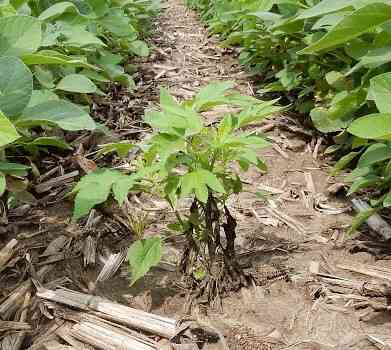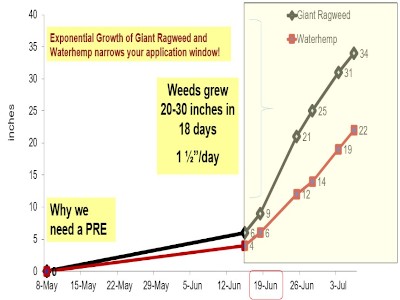
Figure 1. Herbicide applied on giant ragweed when it was
too large. This plant had many growing points that were
able to recover after the herbicide application.
Weeds can grow quickly once emerged. Iowa State University weed scientist Bob Hartzler recently posted on Twitter how the growth rate of waterhemp increases as weed size increases. Although it may take waterhemp seedlings 4 days to grow from 1 to 2 inches in height, it may take only another 1.5 days to grow to 3 to 4 inches in height. Waterhemp can quickly exceed 4 to 6 inches, when chemical control is most reliable, making early-season scouting especially important. Figure 2 demonstrates how quickly waterhemp can exceed a height where control is more reliable.

Figure 2. Giant ragweed and waterhemp growth over time.
Plants were measured and monitored at Rochester, MN.
The beginning date is the emergence date.
Follow herbicide application cutoffs and guidelines
Always check the herbicide label for specific guidelines before application. Postemergence (POST) cutoff timing for some of the more common herbicide-resistant technologies include:
- Dicamba technologies: Products labelled for POST application in dicamba-tolerant soybeans (i.e. XtendiMax, FeXapan, Engenia, Tavium) in Minnesota must be made prior to beginning bloom/the R1 stage of soybeans (Tavium label states through the V4 stage of soybean) or no more than 45 days after planting, and not after June 20, whichever occurs first.
- Enlist:
- ENLIST CORN-Apply when weeds are small and corn is no larger than V8 or 30 inches tall, whichever occurs first. Use drop nozzles for corn 30 to 48 inches in height.
- ENLIST SOYBEAN-Apply when weeds are small and any time after emergence but no later than R2 (full flower).
- Glyphosate:
- RR CORN: Apply before corn reaches V8 or 30 inches; use drop nozzles for corn 30 to 48 inches in height (drop nozzles recommended for 24 to 30 inch corn).
- RR SOYBEAN: Apply from emergence (cracking) through flowering (R2 stage).
- Liberty: Apply to small and actively growing weeds, targeting weeds less than 3 inches in height.
- LL CORN-Apply from emergence up to 24” corn or the V7 stage of growth. Use drop nozzles for corn 24 to 36 inches in height.
- LL SOYBEAN-Emergence to bloom or the R1 growth stage.
Be sure to check the herbicide label for application restrictions prior to use and follow the most restrictive guidelines for products in a tank-mix. Adjust application rates as needed depending on weed size and species, and follow label instructions regarding adjuvants, surfactants and oils, mixing order, allowable tank-mix partners, potential antagonism with tank-mix partners, etc.
Manage for herbicide resistance
The prevalence of herbicide resistance continues to be a challenge. In waterhemp, resistance to Group 2 (e.g. First Rate, Pursuit), Group 9 (glyphosate products), and Group 14 (e.g. Flexstar, Cobra) herbicides is widespread in MN. In giant ragweed, resistance to Group 2 and Group 9 herbicides has been confirmed. In populations where these traits are "stacked," POST options are especially limited.
The herbicide diversification strategies developed by U of MN Extension and North Dakota State University are useful tools in the management of herbicide-resistant weeds (z.umn.edu/herboptions2020). Use of PRE herbicides, including the layering of a PRE herbicide around 30 days after planting is another key strategy. A multi-pronged approach that includes non-chemical strategies (e.g. expanded crop rotation, delayed planting, cultivation, hand weeding, prevention of seed production, use of cover crops) will greatly assist in long-term, herbicide-resistant weed management.
Source : umn.edu